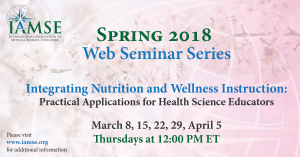
In case you missed the March 15th Webcast Audio Seminar (WAS) Session, here are the highlights of this session:
Fat Chance for Obesity Medicine Education in Medical Schools
Presenter: Nicholas Pennings
March 15, 12 PM ET
- Obesity trends are rising at alarming rates across the United States.
- 57% of children today are projected to have obesity by age 35 (NEJM, 2107)
- The WHO projects that the worldwide cost of obesity will be $1.2 trillion dollars by 2025.
- Obesity can be framed as a disease process, a chronic condition with pathological consequences, which is responsive to lifestyle changes.
- Obesity is both a physical and psychological condition.
- Obesity education is relevant for all medical specialties as it impacts all body systems.
- Currently, 23% of medical schools in the US cover obesity medicine across their undergraduate curriculum and 66% of US medical schools dedicate 2-6 hours to obesity medicine in the their curriculum.
- Barriers to integrating an adequate obesity curriculum into undergraduate medical education include: not enough time, competing curricular demands and lack of prioritization.
- According to studies, there is a predominant “weight bias” in health care that leads to “weight stigma,” which negatively impacts patients with obesity from seeking health care.
- According to the Gayer study (2018), early introduction of an obesity curriculum for students in health care professions demonstrated a sustained reduction in weight bias over four years.
- A brief synopsis of the 2007 AAMC guiding principles for obesity education in undergraduate medical education includes the following:
- Vertically and horizontally integrate obesity education into the medical school curriculum.
- Highlight the universal importance of weight management and the prevention of obesity.
- Utilize a multidisciplinary team to provide social support and behavioral treatment.
- Provide self-awareness training about weight bias and weight stigma.
- Employ population-based/community efforts to better prevent, support, and control obesity.
- Direct basic science instruction to identify and explore the metabolic, genetic and environmental effects of obesity and the metabolic and immunologic responses to obesity.
- Provide opportunities for learners to do a history and physical on patients with obesity and assess these patients in terms of nutrition (impact of different diets), physical activity, behavioral interventions and surgery.
- The ongoing expansion of knowledge in the science of obesity has created a growing chasm between knowledge acquisition and knowledge application for practitioners in the real world.
- Northwestern University, Oklahoma State University College of Osteopathic Medicine and Campbell University College of Osteopathic Medicine are three institutions that have longitudinally integrated Obesity Education. For further details about these, please contact Dr. Nicholas Pennings (pennings@Campbell.edu)
- Additional resources for Obesity Education include the following:
- Obesity Medicine Association (provides free obesity educational materials) www.obesitymedicine.org
- The Obesity Society www.obesity.org
- American Society of Metabolic and Bariatric Surgeons www.asmbs.org
- Obesity Action Coalition (gives voice to patients with obesity)
For more information on the next session or to register, please click here.